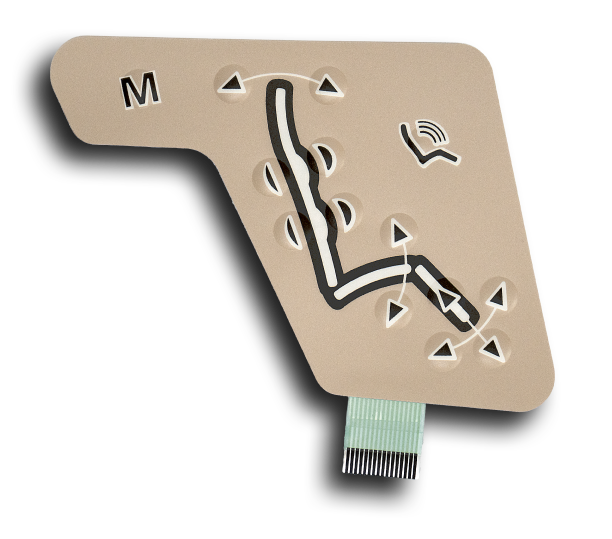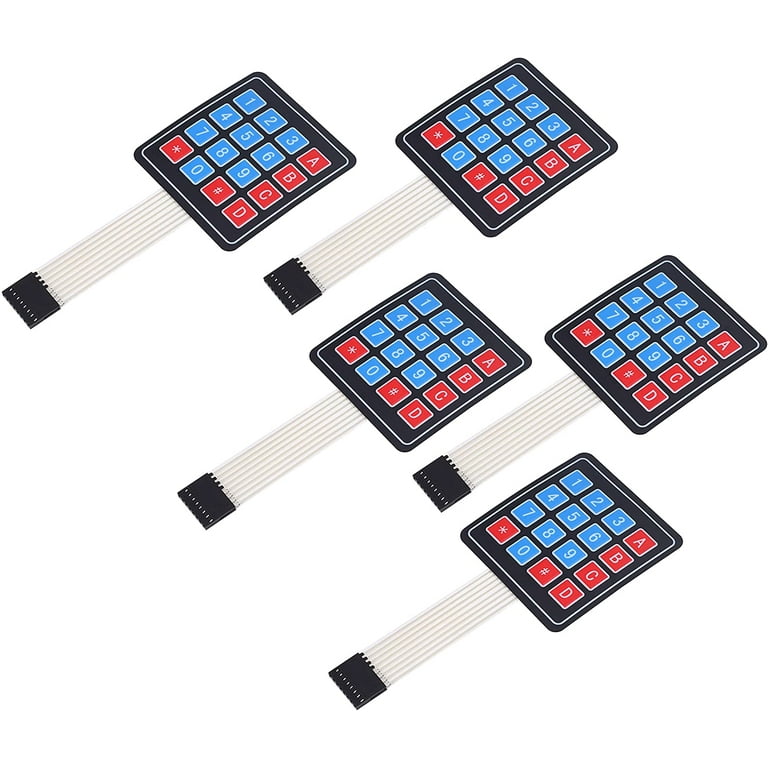Proven Membrane Switch Manufacturer for Top-Tier Control Panels
Proven Membrane Switch Manufacturer for Top-Tier Control Panels
Blog Article
Comprehending the Significance of Membrane Switch in Modern Electronic Devices and Their Applications
Membrane changes function as an essential component in modern electronic devices, offering a reliable interface for individual interaction. Their light-weight and adjustable nature makes them appropriate for a variety of applications across varied industries. Comprehending their essential parts and benefits can give insights into their growing significance. As innovation continues to development, the evolution of Membrane switches over questions about their future applications and design technologies. What exists in advance in this vibrant field?

What Are Membrane Switches?
Membrane switches are essential components in contemporary electronics, serving as customer interfaces that facilitate interaction between devices and customers. These switches include numerous layers, including a graphic overlay, an adhesive layer, and a circuit layer, every one of which interact to develop a sturdy and useful user interface. The style permits for a level, low-profile service that can be customized relating to size, form, and visual appearance, making them suitable for numerous applications, from customer electronics to clinical devices. The tactile responses given by Membrane changes enhances customer experience, while their resistance to dust and dampness makes them perfect for challenging atmospheres. Furthermore, Membrane switches can integrate features such as backlighting and printed graphics, better increasing their functionality. Their convenience and toughness make them a preferred option in industries where dependability and simplicity of usage are paramount, inevitably adding to the smooth procedure of modern-day electronic devices.
Key Elements of Membrane Changes
While different parts add to the performance of a membrane layer button, 3 primary layers play considerable functions in its layout and procedure. The leading layer, typically made from a resilient polymer, serves as the interface for individual interaction, typically including printed graphics and icons. Below this is the spacer layer, which preserves the needed range between the top layer and the circuit layer. This spacer layer guarantees that the button activates just when pushed, protecting against accidental inputs. The circuit layer contains conductive traces that finish the electric circuit when the top layer is depressed. These traces can be made from different products, consisting of copper or silver. Together, these components create a reputable and robust device that is compact and versatile, ideal for a vast array of electronic applications, from house devices to clinical gadgets. Recognizing these crucial parts is vital for valuing the general performance of Membrane buttons.
Benefits of Making Use Of Membrane Switches Over

Membrane Switch Manufacturing Process
Recognizing the Membrane button manufacturing procedure exposes the complex actions entailed in creating these crucial elements. The process usually begins with the layout stage, where formats and specifications are developed using specialized software. Following this, the graphic overlay is printed on a flexible substratum, often using high-resolution printing techniques to assure quality and precision.Next, the adhesive layers are used, which offer to bond the various elements with each other. The circuit layers, made from conductive inks or materials, are then published onto a different substratum. These layers are meticulously lined up and laminated flooring to develop a practical switch.After setting up, the buttons undergo examining to verify functionality and durability. Quality assurance measures are executed throughout the procedure to identify and remedy any type of flaws. Finally, the finished Membrane buttons are packaged and gotten ready for distribution, prepared to fulfill the demands of modern electronic applications.
Applications of Membrane Switches Over in Various Industries
Membrane switches are progressively made use of throughout numerous markets, specifically in clinical equipment and customer electronics. In the clinical field, they supply dependable control interfaces for tools that call for precise procedure. In customer electronic devices, these switches enhance individual communication by using smooth and responsive interfaces.
Medical Equipment Control
Countless modern medical gadgets utilize Membrane buttons for streamlined procedure and enhanced individual interaction. These switches provide a reputable, long lasting user interface for a selection of applications, including diagnostic devices, client tracking systems, and surgical instruments. Their customizable layouts enable for particular formats that can suit the distinct needs of medical care professionals, making sure user-friendly navigating and effective accessibility to vital features. Furthermore, Membrane switches are immune to impurities, making them ideal for sterile settings. The responsive feedback they supply can boost individual self-confidence, decreasing the threat of errors throughout vital medical procedures. Generally, the combination of Membrane buttons in medical equipment greatly adds to boosted functional efficiency and patient security in healthcare settings.
Customer Electronic Devices Interfaces
In the domain of customer electronics, Membrane buttons play an essential role in enhancing customer interfaces across a vast array of devices. These switches are important to products such as remotes, microwaves, and gaming Read More Here consoles, providing a effective and straightforward user interface. Their layout enables for a smooth assimilation of graphics and capability, making it possible for manufacturers to develop sleek, modern-day appearances without endangering usability. Membrane buttons are likewise recognized for their longevity, typically enduring considerable use and direct exposure to numerous environmental problems. Additionally, they can integrate features like backlighting and tactile feedback, further enhancing the customer experience. As consumer demands for sophisticated yet intuitive user interfaces grow, Membrane switches over remain to be a necessary component beforehand electronic tool performance.
Design Considerations for Membrane Changes
Creating reliable Membrane switches requires cautious focus to different variables that affect both capability and user experience. One crucial factor to consider is the option of products, as they can affect toughness, tactile Read More Here responses, and visual allure. Picking an appropriate adhesive is essential for guaranteeing long-term adhesion and resistance to environmental factors.In enhancement, the layout and style of the button should accommodate user interaction, with switch sizes and spacing enhanced for simplicity of usage. The incorporation of graphics and labeling ought to prioritize clarity and exposure under numerous lighting conditions.Consideration of electric attributes, such as actuation pressure and button sensitivity, will certainly boost the responsiveness of the Membrane switch. Furthermore, the layout should accommodate producing click procedures to guarantee cost-effectiveness and timely manufacturing. On the whole, a well-balanced style enhances both the performance and the user experience of Membrane switches in modern-day electronics.

Future Fads in Membrane Switch Technology
As innovation proceeds to evolve, Membrane switches are positioned to integrate brand-new developments that will certainly boost their performance and application in various areas. One considerable trend is the incorporation of sturdy and versatile materials, which will certainly enhance the life-span and dependability of these buttons. Enhanced surface area appearances and personalized graphics are additionally expected, enabling even more instinctive user interfaces.Moreover, the assimilation of wise technology, such as touch-sensitive surface areas and haptic responses, is expected to improve individual interaction, making Membrane switches over more appealing and responsive. Furthermore, developments in printed electronics will make it possible for much more intricate wiring within thinner profiles, even more increasing design possibilities.Sustainability will certainly additionally play a crucial function in future developments, as manufacturers discover environmentally friendly products and manufacturing procedures. Overall, these fads will certainly guarantee that Membrane switches stay pertinent and essential in a significantly electronic and interconnected globe.
Regularly Asked Concerns
Just How Do Membrane Switches Compare to Typical Mechanical Switches?
Membrane switches over deal benefits over standard mechanical buttons, consisting of lowered size, lighter weight, and boosted toughness. They generally supply a sealed surface area, improving resistance to dirt and dampness, making them perfect for varied applications.
What Materials Are Generally Utilized in Membrane Switch Construction?

Can Membrane Switches Withstand Extreme Environmental Issues?
Membrane buttons can hold up against extreme ecological conditions, relying on their layout and products. Top quality buildings usually include longevity versus temperature level changes, humidity, and exposure to chemicals, making them ideal for various demanding applications across markets.
How Lengthy Do Membrane Changes Normally Last Prior To Failure?
Membrane changes usually show a life-span varying from 1 to 10 million actuations, depending on factors such as use frequency, environmental problems, and producing top quality. Normal upkeep can prolong their resilience and functional reliability considerably.
Are Membrane Switches Adjustable for Details Applications?
Membrane buttons are undoubtedly customizable for certain applications. They can be customized in capability, style, and dimension, enabling suppliers to fulfill distinct customer needs and improve item aesthetic appeals while keeping functional efficiency and resilience. Membrane switches are important parts in contemporary electronic devices, offering as customer interfaces that promote interaction between users and gadgets. The responsive feedback given by Membrane changes improves user experience, while their resistance to dust and dampness makes them perfect for testing settings. The unification of graphics and labeling ought to prioritize quality and visibility under various lighting conditions.Consideration of electrical features, such as actuation pressure and switch sensitivity, will boost the responsiveness of the Membrane switch. Boosted surface textures and personalized graphics are likewise prepared for, permitting for more user-friendly individual interfaces.Moreover, the assimilation of smart modern technology, such as touch-sensitive surfaces and haptic feedback, is anticipated to enhance customer communication, making Membrane changes a lot more receptive and interesting. Membrane switches deal benefits over conventional mechanical switches, consisting of reduced size, lighter weight, and enhanced sturdiness.
Report this page